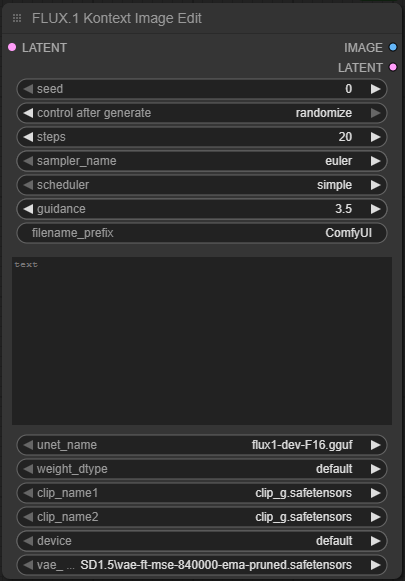Flux.1 Kontext Image Edit
When your latent needs a glow-up — with precision, style, and zero tolerance for bad prompts.
🧩 What is Flux.1 Kontext Image Edit?
The Flux.1 Kontext Image Edit node lets you edit images with surgical-level precision by manipulating latent space using a prompt. Unlike traditional text-to-image models, this one starts from a LATENT input — not a blank canvas — allowing you to transform an existing image while preserving its structure and composition.
It supports both flux-kontext-pro and flux-kontext-max models, and outputs both a freshly generated IMAGE and the updated LATENT, making it ideal for chaining edits across multiple stages of a workflow.
Think of it as the "Photoshop Liquify" tool, but powered by diffusion and a few thousand GPU cycles.

🚧 Special Requirements
- ✅ Requires a valid LATENT input (e.g., from a prior generation or encoding step).
- ✅ Needs a compatible model (
flux-kontext-proorflux-kontext-max) loaded and wired up viaUNet,CLIP, andVAE. - ✅ CLIP 1 and 2, UNet, and VAE must match the model family or your outputs will look like Picasso on acid.
- ✅ This is not a standalone image editor — it’s one piece in a latent-space editing pipeline.
🔌 Inputs and Outputs
Inputs
- LATENT – The latent representation of the image you want to modify.
Outputs
- IMAGE – The resulting image after applying the edit.
- LATENT – The updated latent representation after generation.
⚙️ Node Settings & Parameters
Each field has its own quirks, strengths, and "how-did-this-make-things-worse" settings. Let's dig in.
🔢 seed
- Controls the randomness.
- Same prompt + same seed = same result.
- Useful for reproducibility or batch processing.
🔁 control_after_generate
- Options:
fixed– Keeps the same seed every time.increment– Adds 1 to the seed on each generation.decrement– Subtracts 1 on each generation.randomize– Full chaos mode; fresh seed every time.
🐾 steps
- Determines the number of inference steps (aka: how long the model refines the image).
- Lower = faster, but coarser.
- Higher = slower, but more detailed.
- Sweet spot: 20–40 steps for most edits.
🧪 sampler_name
- Choose your sampler:
euler,dpmpp_2m,lcm, etc. - Each affects how the image evolves through steps.
- For deep nerding, see the Sampler + Scheduler Compatibility Matrix.
📅 scheduler
- Schedulers determine how noise levels are distributed during diffusion.
- Examples:
normal,karras,exponential,ddim_uniform,kl_optimal - Some samplers work best with specific schedulers. Choose wisely or expect unholy artifacts.
🧭 guidance
- AKA "Classifier-Free Guidance Scale" or "CFG."
- Higher values force the image to obey the prompt more strictly.
- Range: ~1–20
- Low (1–5) = Loose interpretations
- Medium (6–12) = Balanced
- High (13+) = Obsessive rule-following (sometimes at the cost of quality)
🗂️ filename_prefix
- Customizes the filename of the generated image.
- Handy for batch runs or tracking changes across iterations.
- Examples:
"edit_pass1_","cat_armor_variant_"
📝 prompt
- This is where you tell the model what changes you want.
- More detail = better edits.
- Vague nonsense = latent hallucinations.
🧠 unet_name
- Selects the diffusion backbone (UNet).
- Must match the chosen
flux-kontextmodel. - Wrong UNet = broken generations or mismatched results.
🔬 weight_dtype
- Options:
default– Uses the default precision (typically FP16)fp8_e4m3fn– Fastest, lowest precisionfp8_e4m3fn_fast– Even faster, still low precisionfp8_e5m2– Slightly better balance
- Why this matters: Impacts speed vs. accuracy vs. VRAM.
- Use
defaultfor most cases unless you're fine-tuning for performance.
🧠 clip_name1 / clip_name2
- Dual CLIP encoders that handle your text prompt.
- Must match your model’s architecture. If you're not sure, refer to the model card/documentation.
- Using the wrong ones can cause weird interpretations or semantic confusion.
⚙️ device
- Options:
default– Use whatever is available (ideally CUDA/GPU)cpu– For when you're testing... or into self-punishment
- Note: Flux-Kontext models are large. Running on CPU = slow, sad days.
🖼️ Image Preview
- A compact thumbnail preview of the output image.
- Fast visual feedback to confirm you're not making visual soup.
✅ Use Cases
- Prompt-guided transformation of existing latent outputs.
- Multi-stage image editing workflows (e.g., generation → inpainting → stylization).
- Style changes, detail enhancement, or object replacement without losing layout.
- Controlled batch editing with reproducible seeds.
🧪 Prompting Tips
- Be specific. “Change the dress to red” > “make it better.”
- Include modifiers like lighting, mood, material, or art style for more directed edits.
- Use negative prompting in your pipeline if needed (e.g., “no blur, no text”).
- Lower
guidanceandstepsfor light edits. Higher values for total overhauls.
🔥 What-Not-To-Do-Unless-You-Want-a-Fire
- ❌ Feed it raw images instead of LATENTs.
- ❌ Mismatch your
unet_name/clip_name1/2with the actual model. - ❌ Forget to load a VAE — you’ll get no image output.
- ❌ Use CPU for full-size editing unless you enjoy 10-minute render times.
- ❌ Assume fp8 will always save you. Precision matters in high-detail edits.
⚠️ Known Issues
- Missing components: Forgetting to load CLIPs or VAE will break the node.
- Precision loss: Lower
weight_dtypesettings can cause loss of subtle details. - Latent drift: High guidance or many steps can deviate too far from the original image.
- No preview update: Some changes (e.g., device) may not reflect immediately in the preview section.
📝 Final Notes
The Flux.1 Kontext Image Edit node is a cornerstone of editable, prompt-driven diffusion workflows. It brings powerful latent manipulation into a composable node-based system that gives you control — with just enough room for chaos if you want it.
Plug it into your workflow, match your components properly, and enjoy prompt-guided editing that doesn't feel like rolling the dice.